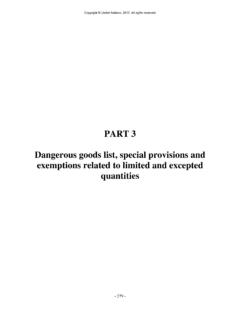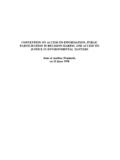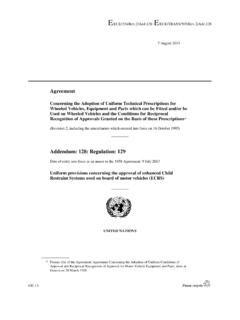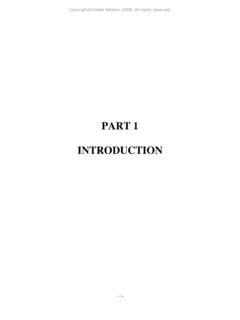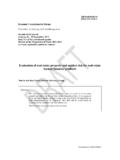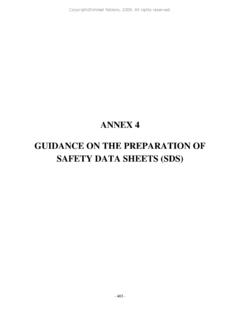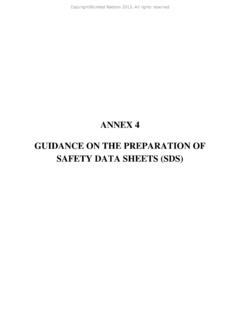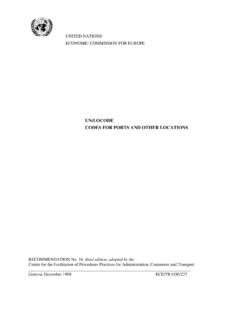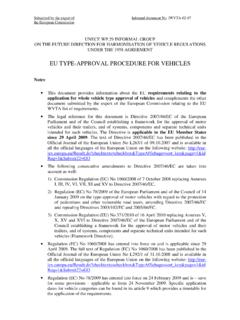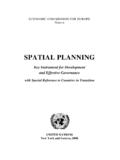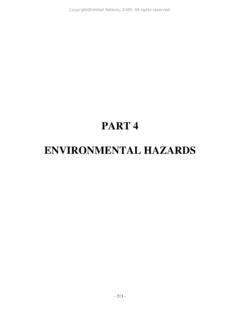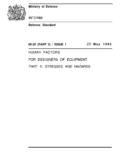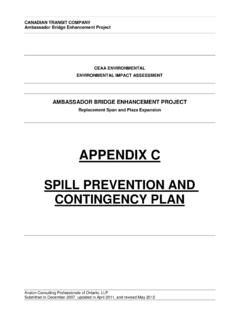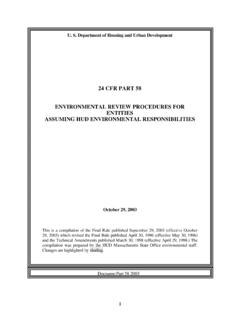Transcription of PART 4 ENVIRONMENTAL HAZARDS - UNECE Homepage
1 part 4 ENVIRONMENTAL HAZARDS Copyright@United Nations 2013. All rights reserved Copyright@United Nations 2013. All rights reserved - 219 - CHAPTER HAZARDOUS TO THE AQUATIC ENVIRONMENT Definitions and general considerations Definitions Acute aquatic toxicity means the intrinsic property of a substance to be injurious to an organism in a short-term aquatic exposure to that substance. Availability of a substance means the extent to which this substance becomes a soluble or disaggregate species. For metal availability, the extent to which the metal ion portion of a metal (M ) compound can disaggregate from the rest of the compound (molecule). Bioavailability (or biological availability) means the extent to which a substance is taken up by an organism, and distributed to an area within the organism. It is dependent upon physico-chemical properties of the substance, anatomy and physiology of the organism, pharmacokinetics, and route of exposure.
2 Availability is not a prerequisite for bioavailability. Bioaccumulation means net result of uptake, transformation and elimination of a substance in an organism due to all routes of exposure ( air, water, sediment/soil and food). Bioconcentration means net result of uptake, transformation and elimination of a substance in an organism due to waterborne exposure. Chronic aquatic toxicity means the intrinsic property of a substance to cause adverse effects to aquatic organisms during aquatic exposures which are determined in relation to the life-cycle of the organism. Complex mixtures or multi-component substances or complex substances means mixtures comprising a complex mix of individual substances with different solubilities and physico-chemical properties. In most cases, they can be characterized as a homologous series of substances with a certain range of carbon chain length/number of degree of substitution.
3 Degradation means the decomposition of organic molecules to smaller molecules and eventually to carbon dioxide, water and salts. ECx means the concentration associated with x% response. Long-term (chronic) hazard, for classification purposes, means the hazard of a chemical caused by its chronic toxicity following long-term exposure in the aquatic environment. NOEC (No Observed Effect Concentration) means the test concentration immediately below the lowest tested concentration with statistically significant adverse effect. The NOEC has no statistically significant adverse effect compared to the control. Short-term (acute) hazard, for classification purposes, means the hazard of a chemical caused by its acute toxicity to an organism during short-term aquatic exposure to that chemical. Copyright@United Nations 2013. All rights reserved - 220 - Basic elements The basic elements for use within the harmonized system are: (a) acute aquatic toxicity; (b) chronic aquatic toxicity; (c) potential for or actual bioaccumulation; and (d) degradation (biotic or abiotic) for organic chemicals.
4 While data from internationally harmonized test methods are preferred, in practice, data from national methods may also be used where they are considered as equivalent. In general, it has been agreed that freshwater and marine species toxicity data can be considered as equivalent data and are preferably to be derived using OECD Test Guidelines or equivalent according to the principles of Good Laboratory Practices (GLP). Where such data are not available classification should be based on the best available data. Acute aquatic toxicity Acute aquatic toxicity would normally be determined using a fish 96 hour LC50 (OECD Test Guideline 203 or equivalent), a crustacea species 48 hour EC50 (OECD Test Guideline 202 or equivalent) and/or an algal species 72 or 96 hour EC50 (OECD Test Guideline 201 or equivalent). These species are considered as surrogate for all aquatic organisms and data on other species such as Lemna may also be considered if the test methodology is suitable.
5 Chronic aquatic toxicity Chronic toxicity data are less available than acute data and the range of testing procedures less standardized. Data generated according to the OECD Test Guidelines 210 (Fish Early Life Stage), or 211 (Daphnia Reproduction) and 201 (Algal Growth Inhibition) can be accepted (see also Annex 9, para. ). Other validated and internationally accepted tests could also be used. The NOECs or other equivalent ECx should be used. Bioaccumulation potential The potential for bioaccumulation would normally be determined by using the octanol/water partition coefficient, usually reported as a log Kow determined by OECD Test Guideline 107 or 117. While this represents a potential to bioaccumulate, an experimentally determined Bioconcentration Factor (BCF) provides a better measure and should be used in preference when available.
6 A BCF should be determined according to OECD Test Guideline 305. Rapid degradability ENVIRONMENTAL degradation may be biotic or abiotic ( hydrolysis) and the criteria used reflect this fact (see ). Ready biodegradation can most easily be defined using the biodegradability tests (A-F) of OECD Test Guideline 301. A pass level in these tests can be considered as indicative of rapid degradation in most environments. These are freshwater tests and thus the use of the results from OECD Test Guideline 306 which is more suitable for marine environments has also been included. Where such data are not available, a BOD(5 days)/COD ratio is considered as indicative of rapid degradation. Abiotic degradation such as hydrolysis, primary degradation, both abiotic and biotic, degradation in non-aquatic media and proven rapid degradation in the environment may all be considered in defining rapid degradability.
7 Special guidance on data interpretation is provided in the Guidance Document (Annex 9). Copyright@United Nations 2013. All rights reserved - 221 - Other considerations The harmonized system for classifying substances for the HAZARDS they present to the aquatic environment is based on a consideration of existing systems listed in The aquatic environment may be considered in terms of the aquatic organisms that live in the water, and the aquatic ecosystem of which they are part . To that extent, the proposal does not address aquatic pollutants for which there may be a need to consider effects beyond the aquatic environment such as the impacts on human health etc. The basis, therefore, of the identification of hazard is the aquatic toxicity of the substance, although this may be modified by further information on the degradation and bioaccumulation behaviour. While the scheme is intended to apply to all substances and mixtures, it is recognized that for some substances, metals, poorly soluble substances, etc.
8 , special guidance will be necessary. Two guidance documents (see annexes 9 and 10) have been prepared to cover issues such as data interpretation and the application of the criteria defined below to such groups of substances. Considering the complexity of this endpoint and the breadth of the application of the system, the Guidance Documents are considered an important element in the operation of the harmonized scheme. Consideration has been given to existing classification systems as currently in use, including the European Union supply and use scheme, the revised GESAMP hazard evaluation procedure, IMO scheme for marine pollutants, the European road and rail transport scheme (ADR/RID), the Canadian and United States of America pesticide systems and the United States of America land transport scheme. The harmonized scheme is considered suitable for use for packaged goods in both supply and use and multimodal transport schemes, and elements of it may be used for bulk land transport and bulk marine transport under MARPOL 73/78 Annex II insofar as this uses aquatic toxicity.
9 Classification criteria for substances Whilst the harmonized classification system consists of three short-term (acute) classification categories and four long-term (chronic) classification categories, the core part of the harmonized classification system for substances consists of three short-term (acute) classification categories and three long-term (chronic) classification categories (see Table (a) and (b)). The short-term (acute) and the long-term (chronic) classification categories are applied independently. The criteria for classification of a substance in Acute 1 to 3 are defined on the basis of the acute toxicity data only (EC50 or LC50). The criteria for classification of a substance into Chronic 1 to 3 follow a tiered approach where the first step is to see if available information on chronic toxicity merits long-term hazard classification.
10 In absence of adequate chronic toxicity data, the subsequent step is to combine two types of information, acute toxicity data and ENVIRONMENTAL fate data (degradability and bioaccumulation data) (see Figure ). The system also introduces a safety net classification (Chronic 4) for use when the data available do not allow classification under the formal criteria but there are nevertheless some grounds for concern. The precise criteria are not defined with one exception: for poorly water soluble substances for which no toxicity has been demonstrated, classification can occur if the substance is both not rapidly degraded and has a potential to bioaccumulate. It is considered that for such poorly soluble substances, the toxicity may not have been adequately assessed in the short-term test due to the low exposure levels and potentially slow uptake into the organism.
